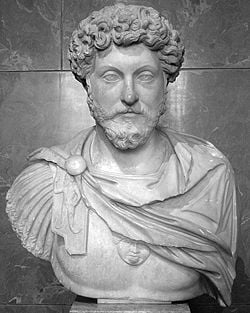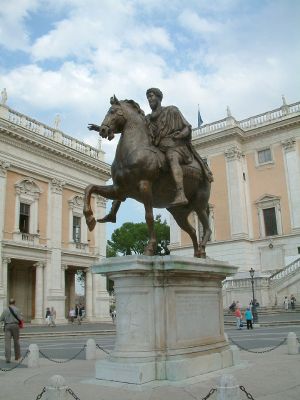Marcus Aurelius
Template:Antonine dynasty Imperator Caesar Marcus Aurelius Antoninus Augustus (April 26 121 – March 17 180) was Roman Emperor from 161 to his death. He was born Marcus Annius Catilius Severus, and at marriage took the name Marcus Annius Verus. When he was named Emperor, he was given the name Marcus Aurelius Antoninus. He was the last of the Five Good Emperors.
Life
Adoption by Antoninus
He was Antoninus Pius' nephew and the son of Hadrian's brother-in-law. Therefore, on the death of Hadrian's first adopted son Aelius Verus, Hadrian made it a precondition of making Antoninus his successor that Antoninus would adopt Marcus (then called Marcus Annius Verus) and Lucius Verus (Aelius Verus' son), and arrange for them to be next in the line.
This Antoninus did, adopting and designating them as his successors on February 25 138, when Marcus was only seventeen years of age.
Roman emperor
Joint emperorship
When Antoninus died on March 7 161, Marcus accepted the throne on the condition that he and Verus were made joint emperors (Augusti), with Verus partly subordinate. This was partly because the two were Antoninus' joint heirs.
The joint succession may have also been motivated by military exigences, since, during his reign, Marcus Aurelius was almost constantly at war with various peoples outside the empire. A highly authoritative figure was needed to command the troops, yet the emperor himself could not defend both the German and Parthian fronts at the same time. Neither could he simply appoint a general to lead the legions; earlier popular military leaders like Julius Caesar and Vespasian had used the military to overthrow the existing government and install themselves as supreme leaders. Marcus Aurelius solved the problem by sending Verus to command the legions in the east. He was authoritative enough to command the full loyalty of the troops, but already powerful enough that he had little incentive to overthrow Marcus. The plan succeeded—Verus remained loyal until his death on campaign in 169.
This joint emperorship was faintly reminiscent of the political system of the Roman Republic, which functioned according to the principle of collegiality and did not allow a single person to hold supreme power. Joint rule was revived by Diocletian's establishment of the Tetrarchy in the late 3rd century.
Aurelius' wars
Germany and the Danube
Germanic tribes and many people had launched many raids along the Northern border, particularly into Gaul and across the Danube— Germans, in turn, may have been under attack from more warlike tribes farther east. His campaigns against them are commemorated on the Column of Marcus Aurelius.
Parthia
In Asia, a revitalized Parthian Empire renewed its assault. Marcus Aurelius sent his joint emperor Verus to command the legions in the east to face this threat. On the return from the victorious campaign, Verus was awarded with a triumph; the parade was unusual because it included Verus, Marcus Aurelius, their sons and unmarried daughters as a big family celebration.
Writings
While on campaign between 170 and 180, Aurelius wrote his Meditations as a source for his own guidance and self-improvement. He had been a priest at the sacrificial altars of Roman service and was an eager patriot. He had a logical mind though his notes were representative of Stoic philosophy and spirituality. Meditations is still revered as a literary monument to a government of service and duty. It has been praised for its "exquisite accent and its infinite tenderness" and "saintliness" being called the "gospel of his life." They have been compared by John Stuart Mill in his Utility of Religion to the Sermon on the Mount.
The book itself was first published in 1558 in Zurich, from a manuscript copy that is now lost. The only other surviving complete copy of the manuscript is in the Vatican library.
Contacts with China
Death
Marcus Aurelius died on March 17 180 during the expedition against the Marcomanni and Quadi in the city of Vindobona (modern Vienna). His ashes were returned to Rome and rest in Hadrian's mausoleum (modern Castel Sant'Angelo). He was also commemorated by a column in Rome.
Succession and historical legacy
He was able to secure the succession for his son Commodus, whom he made co-emperor in his own lifetime (in 177), though the choice may have been unknowingly unfortunate. Commodus was a political and military outsider, as well as an extreme egotist. Many historians believe that the decline of Rome began under Commodus. For this reason, Aurelius' death is often held to have been the end of the Pax Romana.
Depictions in art and modern popular culture
Ancient art
A well preserved bronze equestrian sculpture of Marcus Aurelius, which, during the Middle Ages, had stood in the Lateran Palace in Rome, was relocated in 1538 to the Piazza del Campidoglio (Capitoline Hill). Currently, the original is on display in an exhibition room designed especially for this purpose in the Palazzo dei Conservatori of the Musei Capitolini, while a copy has replaced it in the square. It was standard practice to melt down bronze statues for reuse as coin or new sculptures (eg in the late empire, following Rome's conversion to Christianity, to make new statues for the new Christian churches), and that is why so few bronze statues, let alone statues of emperors, survive. The reason this one was not melted down was that, when in late antiquity or the early medieval period its turn came, it was incorrectly thought to portray the 'christianising' Emperor Constantine. Indeed, it is the only fully surviving bronze statue of a pre-Christian Roman emperor and so survived.
According to accounts from medieval times, a small figure of a bound barbarian chieftain once crouched underneath the horse's front right leg. In addition, it was one of the few Roman statues to remain on public view during the Middle Ages. Such an image was meant to portray the Emperor as an always victorious all-conquering lord of the earth. However, shown without weapons or armor, Marcus Aurelius seems to be a bringer of peace rather than a military hero, for this is how he saw himself and his reign.
This statue is such a trademark image that it is the subject of a €0.50 Italian euro coin designed by Roberto Mauri.
Appearances in modern literature
- Mémoires d'Hadrien (1951), a fictitious but plausible autobiography (in form of a series of letters directed to his adoptive grandson "Marcus") of one of his predecessors, Hadrian, by Marguerite Yourcenar. It is one of the best-selling European novels of the 20th century.
- Household Gods (1999 novel), by Judith Tarr and Harry Turtledove. (ISBN 0613351479)
Film
- The Fall of the Roman Empire (1964 film), played by Alec Guinness
- Gladiator (2000 film), played by Richard Harris
- The movie The Silence of the Lambs publicized Marcus Aurelius' principle, from Meditations: "For any particular thing, ask, 'What is it in itself? What is its nature?'".
- AlecGuinessMarcusAurelius.jpg
Alec Guinness as Marcus Aurelius
- Rharris.jpg
Richard Harris as Marcus Aurelius in Gladiator
Marriage and issue
Aurelius married Faustina the Younger in 145. During their 30-year marriage Faustina bore thirteen children, most notably, his son Commodus who would become later Emperor, and his daughter Lucilla, who was wed to Lucius Verus to solidify his alliance with Marcus Aurelius.
External links
Primary sources
- The Meditations:
- at Onlinebooks (Casaubon translation)
- MITedu (Translated by George Long) Historia Augusta: Life of Marcus Aurelius
- Bartleby
- Works by Marcus Aurelius. Project Gutenberg
Secondary material
- Internet Encyclopedia of Philosophy entry
- Marcus Aurelius entry at De Imperatoribus Romanis
- Marcus Aurelius entry at Livius.Org
| Preceded by: Antoninus Pius |
Roman Emperor 161–180 (with Lucius Verus 161–169) |
Succeeded by: Commodus |
| Antonine Dynasty 96–192 | ||
| Nervan-Antonian Dynasty 96–192 | ||
| Preceded by: Antoninus Pius |
Five Good Emperors 96–180 |
Succeeded by: (none) |
Credits
New World Encyclopedia writers and editors rewrote and completed the Wikipedia article in accordance with New World Encyclopedia standards. This article abides by terms of the Creative Commons CC-by-sa 3.0 License (CC-by-sa), which may be used and disseminated with proper attribution. Credit is due under the terms of this license that can reference both the New World Encyclopedia contributors and the selfless volunteer contributors of the Wikimedia Foundation. To cite this article click here for a list of acceptable citing formats.The history of earlier contributions by wikipedians is accessible to researchers here:
The history of this article since it was imported to New World Encyclopedia:
Note: Some restrictions may apply to use of individual images which are separately licensed.




